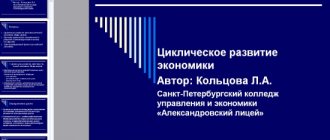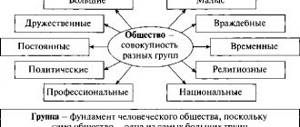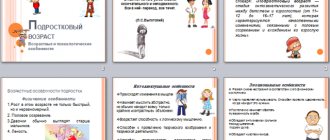Social studies lesson on the topic “World Economy”
Social studies lesson on the topic “World Economy”
Purpose: to consider the basic principles of the functioning of the world economy.
Subject: social studies.
Grade: 11.
Date: "____" ____.20___
Teacher:
I.
Statement of the topic and purpose of the lesson.
II. Presentation (with elements of conversation) of program material.
Why do countries trade? Is it possible to isolate yourself from each other? What are the pros and cons of the globalization process?
Until now, we have looked at the national economy and said nothing about connections with the outside world. But there are a lot of such connections in our lives. We go to the store and see there, along with domestic ones, a lot of goods from different countries of the world. In companies, organizations and in their homes, many have imported computers, equipment or household appliances, also from different countries. People from Russia go to work or study abroad, and from other countries, on the contrary, come to study and work in Russia.
All this speaks of the connections and dependence of different countries on each other within the framework of the world economy.
What is the world economy?
World economy -
it is a set of economies of individual countries interconnected by a system of international economic relations.
What relationships are meant? This is, first of all, the international division of labor, which forms the basis of international trade in goods and services, this is the international movement of capital and labor, these are currency relations. Many countries have generally united into blocs and removed almost all barriers to the movement of goods, capital and labor. This phenomenon is called integration.
But the beginning of all these processes in the world economy is the international division of labor.
International division of labor –
This is the specialization of countries in the production of certain products. The prerequisites for specialization are:
1) natural conditions of the country - climate, geographical location, availability of minerals and other natural resources. For example, countries that have certain mineral resources (remember the distribution of mineral resources from geography) sell them to countries that do not have them, and in return buy products that they themselves do not produce;
2) level of economic, scientific and technical development. From the section on economic growth, you know that countries develop unevenly. Economically developed countries, as a rule, specialize in the production of finished products, while developing countries specialize in the production of raw materials;
3) established traditions in the production of certain goods. For example, France is famous for its cosmetics, and Brazil for its coffee.
international trade
If there is an international division of labor, then there is international trade. No matter how large a country is, it cannot produce all the goods it needs. But large and rich countries can better provide themselves with most of the goods they need. In addition, if such countries have a large population, then they have a significant domestic market and there is less surplus left that needs to be exported to other countries.
The basic terms of international trade are exports, imports and trade balance.
Export –
These are goods and services that are exported abroad for the purpose of sale on the world market.
Import –
These are goods and services that are imported into a country for the purpose of selling them on the domestic market.
Trade balance –
the difference between the value of exports and imports for a certain period. For example, the United States, the most developed and richest country in the world, constantly has a negative trade balance, that is, imports into the United States significantly exceed exports. Russia, on the contrary, exports more goods (remember that these are mainly raw materials) than it imports, and its trade balance is positive.
International trade has a very ancient history. This is the first form of economic relations between countries. From history you remember that in the XVII-XVIII centuries. the largest trading power was the Netherlands, followed by Great Britain.
Back in the 17th century. Economists have asked the question: “Why do countries trade with each other?” At the time, they believed that foreign trade created wealth, which was associated with gold, and urged governments to export more goods to obtain more gold for the country, and import less so that there would be no outflow of gold.
But already in the second half of the 18th century, when the industrial revolution began in England, that is, the transition from manufacturing to factory production, the attitude towards trade changed. The Scottish scientist Adam Smith () criticized the idea of wealth as owning a large amount of gold and showed “how a state grows rich and what it lives on, and why it does not need gold when the product is simple
It has" ().
A. Smith highly valued the division of labor and believed that it was profitable for citizens of any country to buy foreign goods, especially if they were sold cheaper than domestic ones. The scientist developed the theory of absolute advantage in foreign trade,
the essence of which is that some countries can produce goods more efficiently than others, and therefore have an absolute advantage in free trade with other countries. Russia, for example, has an absolute advantage in gas, which it produces more than anyone else in the world. Our country supplies gas to developed European countries in exchange for equipment, since its production in Russia is less efficient.
Another English economist David Ricardo () developed the theory of comparative advantage in foreign trade.
Its essence was that a country benefits if it specializes in the production of those goods whose average costs are relatively lower than in the production of the same goods in other countries. D. Ricardo, as an example of a mutually beneficial exchange between England and Portugal, cited the exchange of goods such as cloth (remember that England was the “workshop of the world”?) and wine, since Portugal is located south of England and the natural conditions there are more favorable for growing grapes.
Currently, almost all countries are involved in world trade. But the share of individual countries in world exports and imports varies greatly. The share of developed countries in world trade in 2000 was 72% for exports and 75.8% for imports.
The largest share in world exports and world imports falls on the United States - 13 and 20.3%, respectively, Germany is in second place - 8.9 and 8.1%, and Japan is in third place - 8.0 and 6.1%. Russia's share is more than modest: in world exports - 1.7%, in world imports - 0.5%.
Now let's see what Russia's foreign trade is. The specificity of Russian exports is that most of them are fuel and energy raw materials and mining industry products. In 2001, the export of these products accounted for 60.4%, the share of manufacturing products (for example, mechanical engineering, instrument making, etc.) was 37.8%, agriculture and food industry - 1.8%. In terms of imports in 2001, machinery and equipment took first place - 33.2%, agricultural products and food took third place - 22%.
The main partners of modern Russia: for export -
Germany (9.3%), Italy (7.5%), China (5.6%), Ukraine and Belarus (5.3% each);
for imports -
Germany (13.9%), Belarus (9.5%), Ukraine (9.2%), USA (7.7%), Kazakhstan (4.8%).
Is foreign trade beneficial for the state? On the one hand, the answer is positive - it is profitable, because consumers, as a rule, receive high-quality goods, often at lower prices. But, on the other hand, the goods of domestic producers do not withstand competition, are not in demand, their production is reduced, people lose wages and jobs, which means their solvency is reduced. These are the negative aspects of foreign trade.
State policy in the field of international trade will help get out of this situation.
State policy in the field of international trade
For more than one century, two interrelated trends, or two economic policies of the state, have persisted in international trade. These are protectionism and free trade (free trade).
Protectionism
(French
protectionisme
from Latin
protectio –
literally “cover”) is a state policy aimed at protecting the interests of domestic producers from foreign competitors.
Free trade –
This is a state policy aimed at the free development of international trade.
Protectionism appeared a very long time ago, back in the 17th-18th centuries, and was expressed in the establishment by the state of import duties on those goods whose import was undesirable. The duties constituted a certain percentage of the price of the goods and greatly increased the cost of imported goods, which became less competitive compared to local goods. In Russia, customs tariffs were first introduced by Peter I.
Get full text
Free trade policies began to be applied in England in the mid-19th century. But it became widespread only after the Second World War, i.e., from the middle of the 20th century.
Currently, this policy is manifested in the liberalization of free trade and the transition of many countries to an open economy. However, free trade policies have their advantages and disadvantages.
To the positive features
First of all, we should include the saturation of the national market with cheap and high-quality goods. This means that the population will be able to buy more goods at favorable prices on the world market. The state will collect more taxes both from foreign companies that will transport goods across our borders and from its citizens who will buy these goods. In addition, foreign firms will have to open branches in another country to sell their goods, which will create additional jobs for the local population.
But free trade also has its downsides.
Since the population will prefer higher quality imported goods, the demand for domestic products will fall, manufacturers will reduce production, fire their workers, and pay less taxes to the state. It would be good if foreign competition forced our producers to improve their products, reduce costs, and lower prices. And if not? Then the country’s dependence on foreign goods will increase, their prices will rise, and the majority of the population will not be able to buy them.
In the 80s XX century In Russia there was a shortage of almost all consumer goods, prices were low, and queues were huge. In 1992, the state monopoly on foreign trade was abolished, and foreign goods began to flow into our market in a rapid flow. Trade began to develop, so-called shuttles appeared, which brought cheap goods from Turkey and China and sold them right on the street next to markets and shops. Now this stage has already passed. The consumer has a choice: to buy either imported goods or goods from domestic producers. For example, when it comes to food products, our products have advantages - they are fresh, natural, for the most part without any harmful additives. But, unfortunately, they are more expensive and look less attractive in appearance than beautiful overseas products. We still have a lot to learn in order to satisfy the needs of our consumers with domestic goods as best as possible.
That is why Russia, like many other, even the most developed countries, has not abandoned the policy of protectionism, using different methods of regulating foreign trade.
Let's consider methods of protectionist policy, which can be divided into two large groups - tariff and non-tariff.
To tariff methods of regulation
include customs tariffs on imports and export tariffs, as well as customs unions.
Customs tariffs on imports –
These are duties on imported goods brought into the country, levied by customs departments when crossing the state border. Typically, tariffs for finished products are quite high, and for raw materials and materials – lower. The purpose of such a policy is to raise the domestic price of imported goods above the world price and thus protect domestic producers from foreign competitors.
Export tariff –
This is a tariff on goods of domestic producers in order to limit exports to maintain supply in the domestic market, especially if prices for a given product are kept below the world level by the government. Most often, developing countries and countries with economies in transition resort to such methods. In addition, established export duties provide additional income to the state budget.
Customs unions –
These are associations of countries that eliminate all customs barriers among themselves, but establish them for third countries. An example is the European Union, which includes the former Baltic republics of the USSR (Latvia, Lithuania, Estonia), or the Asia-Pacific Community, which includes Russia.
Towards non-tariff methods of regulation
international trade include the establishment of quotas, export credits, economic sanctions (embargo), dumping, etc.
Setting quotas –
These are quantitative restrictions on the import or export of a certain product. For example, the United States is trying to limit the import of Japanese cars and electronics in order to protect domestic manufacturers from competition. Russia did not set quotas, but raised tariffs on the import of imported cars, especially used ones, which have already worked for 5-7 years and whose price is very low, in order to protect its manufacturers, and thus limited the import of cars.
Quotas are established through licensing, which is carried out by the state. To obtain a license to import goods, foreign companies must send samples of goods to a given country. The time delay and uncertainty associated with this procedure negatively affects foreign trade.
Another method of hidden protectionism for goods imported from abroad is the establishment of standards for certain products. Standards relate to classification, labeling, and testing of products and are often introduced under the guise of protecting public safety and health. For example, the labeling must indicate the composition of the product; if these are food products, then food additives must be indicated. If they do not meet Russian standards, then the import of these products will be prohibited.
Economic sanctions – embargo –
This is a state-imposed complete ban on trade with any other country. The embargo is used mainly to put pressure on this country for political reasons. For example, the United States, which did not want to tolerate a pro-communist country nearby, declared a complete embargo on Cuba in 1962. Sometimes an embargo may be declared on certain goods. Thus, the USA in the early 1980s. declared an embargo on the supply of computers to the USSR under the pretext that this could strengthen the military potential of the Soviet Union.
International trade is developing very quickly and therefore needs regulation by an international organization. Such an organization was created and began to operate in 1948 - this is the General Agreement on Tariffs and Trade. In 1995, it was transformed into the WTO - the World Trade Organization, which regulates about 90% of world trade (as of October 2009, it included 153 states).
The purpose of this organization is to create most favored nation treatment for its members in trade, abolish discrimination and create equal conditions for all participants. The WTO sets common tariffs and fights against non-tariff restrictions on trade - quotas, government subsidies for export industries, tax incentives for exporting enterprises.
Russia has only been a member of the WTO since August 2012, although the USSR also submitted an application to join the organization. The negotiations concerned precisely the non-tariff instruments that Russia uses to protect its industry. Before joining the WTO, Russia was losing, according to our economists, from 1 to 4 billion dollars a year from unfavorable tariffs for countries that were not members of the WTO on the export of metallurgical, chemical, textile and other industries.
Global economic problems
But it is not only international trade that links different countries into a single world economy. Such a connection is found in many other areas of life: in production, financial, currency and information spheres. In short, we are witnessing a process of globalization.
This process began in the second half of the 20th century, when scientific and technological progress began to develop rapidly, and at the end of the last century the process of globalization entered its mature stage, turning our world into a single space and affecting all aspects of the world economy.
In industry, the process of globalization is expressed in the deepening of the international division of labor and in the increasing internationalization of production. If we take technically quite complex products, such as a TV, a computer, a car, then sometimes it is difficult to determine where they were made, because different parts are made not only in different countries, but also on different continents. And this is thanks to transnational corporations (TNCs), which among the largest TNCs control more than half of the world's production of durable goods, cars and other products.
International trade has long overtaken industry in terms of its growth rate, and if we take electronic commerce, for which there are no national borders, then we can assume that its growth will continue. Already in 2002, e-commerce accounted for 10% of global trade volume.
The electronic and information revolution has contributed to the globalization of the world economy. The Worldwide Information Network - the Internet - has brought countries even closer to each other and contributed to financial globalization. By the beginning of 2003, the number of Internet users in the world reached 1 billion. Now, in a matter of seconds, you can transfer multimillion-dollar sums of money from one end of the world to another, sell and buy the necessary goods. But, unfortunately, these wonderful achievements of modern technology serve not only good, but also evil, giving rise to the emergence of new criminal structures, for example, hackers who crack bank computer codes and steal money, or criminal pseudo-firms selling prohibited goods (weapons, drugs).
The process of globalization of the world economy is ambiguous: it carries both positive and negative features. On the one hand, globalization facilitates interaction between different countries, leads to accelerated economic growth, and contributes to an increase in the exchange of advanced achievements of mankind in the economic, scientific, technical and intellectual fields, which, without a doubt, promotes the progress of the entire world economic system. Nowadays there is more and more talk about the “new economy”, an economy based on knowledge. Of course, in the future, more and more attention will be paid to education, because only educated people with knowledge will be able to have access to advanced information technologies.
But on the other hand, globalization often causes serious negative consequences, problems and risks. This is due to the fact that failures in any system are very quickly transmitted to the whole world. A striking example is the Asian and Latin American financial crises, which developed into the global financial crisis.
Organized crime also transcends national boundaries. Global criminalization indicates a weakening role of nation states, and even Interpol (the international police force) cannot stop many economic crimes in this area.
Another very important contradiction born of globalization is the contradiction between the Center and the Periphery. The Center consists of developed countries - the USA, Great Britain, Germany, Japan, etc., and the Periphery - two levels: those countries that are developing at a high rate - East and Southeast Asia, Eastern Europe, Russia, India, Latin America (the so-called Semi-periphery) - and the poorest countries that are unable to overcome poverty are the countries of Africa and the Arab-Muslim world. You already know from the section “Economic Development” §2 about the “vicious circle of poverty”, which is very difficult to overcome. The gap between rich and poor countries is constantly growing. If in 1960 the ratio of incomes of one fifth of the richest countries on the globe and one fifth of the poorest countries was 30: 1, then by the end of the 20th century. it became 74:1. By the end of 2000, the first group of countries produced 86% of world GDP, and the second - only 1%.
Get full text
It would seem that international financial organizations (International Monetary Fund, World Bank, etc.), by providing loans to developing countries, strive to assist them in economic development. But the debts of these countries are growing, and there is no significant economic growth. Africa alone has debts reaching $350 billion. As a result, debt turned into a new form of dependence of the Periphery on the Center, which further widened the gap between them.
As for Russia, we have both material and intellectual resources, and considerable scientific potential, so that the country can take a more worthy place in the world economy.
III. Practical conclusions.
1. The Russian economy developing on a market basis forced the community to discuss the question: which foreign trade policy should be preferred - protectionism or free trade? We advise you to accumulate and analyze information about the foreign economic activities of the state. This will allow you to intelligently judge the prospects for the country’s economic development and assess your opportunities for active participation in its economic life, as well as choose ways to influence economic policy as a voter.
2. As consumers, you know that the best coffee comes from Brazil, radio electronics from Japan, and good business education can be obtained in England, etc. It is useful to use knowledge of the advantages of countries in foreign trade to make a rational choice of goods and services.
3. It is important to monitor the positive results of the process of globalization of the world economy (the successes of the electronic, information revolution) for the successful mastery of the advanced achievements of mankind in the economic, scientific, technical and intellectual fields. Remember that the future is a knowledge-based economy.
IV. Document.
From the work of modern Russian economists,
"The Benefits of Free Trade Policies."
The question of the advantages and disadvantages of the globalization process from the point of view of the interests of individual countries, as well as the world economy as a whole, has become in our time perhaps the main issue of all economic discussions.
The main advantages of “free”, i.e. minimally bound by government restrictions, international trade stem from the simplification of the entry of national producers into world markets for goods, services and capital. As a result, the economy of each individual country, on the one hand, receives certain benefits from participation in the global system of division of labor...
Participation in the global division of labor allows national producers to specialize in those industries for the development of which the country has the most favorable conditions, and increased competition from foreign producers forces them to strive to improve product quality and reduce production costs. All this ultimately leads to increased efficiency of the economies of countries committed to free trade policies, and consumers in these countries gain access to a wider range of goods and services, both domestically produced and imported, at relatively lower prices.
In addition, countries actively involved in international trade benefit from the so-called spillover of new technologies from the economies of their trading partners, for example, through the acquisition of new knowledge embodied in imported machinery and equipment. This technology spillover is especially important for developing countries...
Former socialist countries, in the past artificially, for political reasons, largely isolated from countries with market economies, are now striving to make up for lost profits from trade with all countries of the world without exception.
Questions and tasks for the document
1)
What does free trade mean and what are its main features?
2)
Why do you think former socialist countries did not allow imported goods into their market?
3)
Going to the nearest store, compare imported and domestic goods according to the following parameters: price, quality, packaging.
Which products would you prefer? V. Questions for self-test.
1. When we say “international economic relations,” what kind of relations do we mean?
2. What are the reasons for the international division of labor?
3. Which country, the United States or the Netherlands, do you think is more dependent on international trade and why?
4. Is a positive trade balance good or bad?
5. In what goods does Russia have an absolute advantage in trading and what goods does it have a relative advantage?
6. Why do some states use protectionist policies? Name the goods whose import into Russia is restricted.
7. What aspects of the world economy have been affected by the process of globalization? Is globalization in economics good or bad? Give reasons for your point of view.
VI. Tasks.
1. Country A, using one unit of resource, can produce 1 ton of rice or 4 tons of coal. Country B, also using one unit of resource, will produce 2 tons of rice and 5 tons of coal. What will country B export and import?
2. Exports of country A were equal to 103093 million dollars, and imports were 33879 million dollars; exports of country B for the same year amounted to 781,125 million dollars, and imports - 1,257,640 million dollars. Calculate the foreign trade balance of countries A and B and compare them.
3. Has Russia been affected by the electronic revolution? What does this mean? Give examples.
VII. Thoughts of the wise.
“Great nations are never made poor by the extravagance and imprudence of private persons, but they are often made poor by the extravagance and imprudence of public authority.”
A. Smith (), Scottish economist and philosopher
VIII. Final part.
1. Evaluating student answers.
2. Homework: read §10 “World Economy” (pp. 114-125); complete task No. 3 (p. 125).






